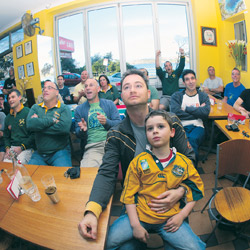Exhibition shows it’s not all black and white
IMAGES of South Africa feature in the Sydney Jewish Museum's latest exhibition, It's Not All Black and White: The South African Jewish Story.

LEXI LANDSMAN
FOR those who lived in South Africa, a lifetime of images, sounds and smells are etched deep into memory: the colour and hue of winter sunsets and Highveld grass; magical Ndebele decorations on huts and kraals (small African villages); slow drives along dusty game park roads ‚Ķ proud nannies with babies on their backs.”
This is the poetic panel inscription that greets viewers at the Sydney Jewish Museum’s (SJM) It’s Not All Black and White: The South African Jewish Story exhibition in the “pulse of life” section.
The exhibition, which closes at the end of the year, has brought in a record 3000 new visitors to the museum since it opened.
The exhibition’s co-curator Roslyn Sugarman, who is the John Saunders Curatorial Chair of the SJM, says she has been overwhelmed by the positive response to the exhibition.
“The exhibition is about South Africans in their own voices. It really shows a diverse range of opinions on all sorts of areas. We’ve had a really positive response to it,” she says.
It features photographs, artefacts and personal stories of South African expats that chronicle South African Jewish life from its beginnings, around the 1840s, through the development of the community and onto the events that led to waves of migration over the past few decades to Australia.
“The South African Jews reinvigorated the Jewish community in Sydney. Their arrival has boosted the numbers in Jewish day schools, increased numbers in synagogues at Friday night services and their demand for kosher products has arguably resulted in a larger variety in supermarkets,” Sugarman said.
Sugarman, who immigrated from South Africa to Australia in 2000, hopes that South African expats will walk away from the exhibition “with a sense of pride and identity, and feeling proud of the contribution that they’ve made to their new home”.
“There are some really positive results of South Africans being here and on so many levels. There is this sense that South Africans get involved, make a difference and contribute meaningfully.”
The exhibition was co-curated by Sugarman and Barbara Linz. The history panels were written by Louise Liebowitz, while Jacqui Wasilewsky headed the oral histories.
The exhibition closes at the end of this year. Enquiries: (02) 9360 7999.

comments